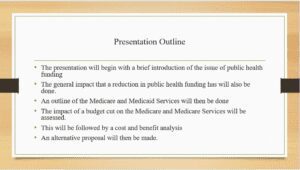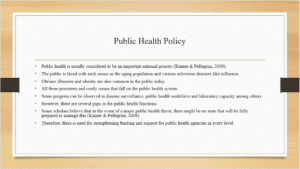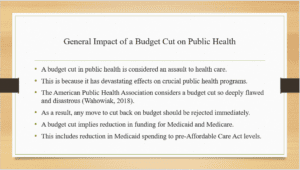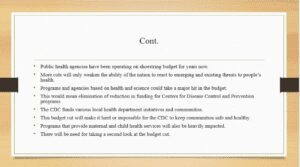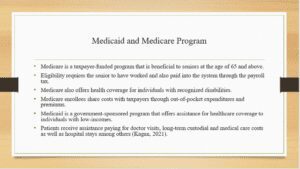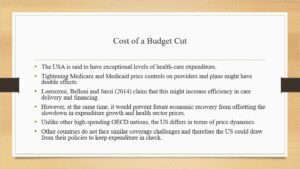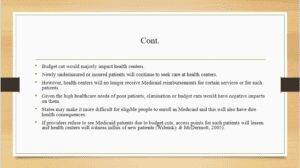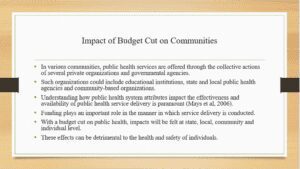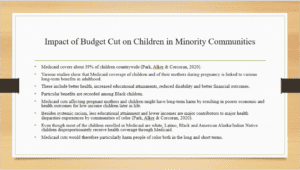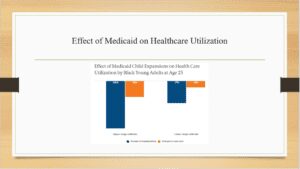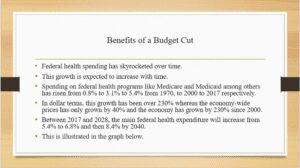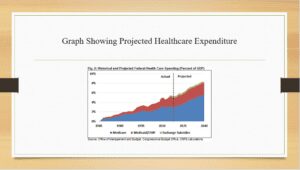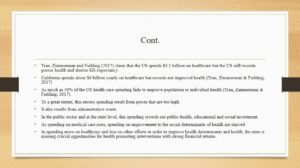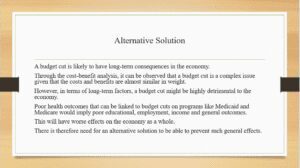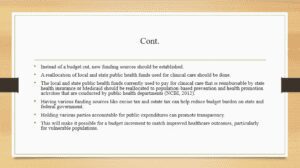Public Health Finance and Economics
Do you need any help in completing your assignment ? Get in touch with us at eminencepapers.com. We undertake to provide you with excellent service.
Hello and welcome to the kick-off public health finance and economics presentation. In this presentation, I will discuss the impact of the recently proposed state budget cut on Medicare and Medicaid Services. A cost/benefit analysis of the public health program will be conducted together with the impact of the suggested amount, and I will conclude with an alternative proposal.
The outline of the presentation is as follows: I will begin with an introduction to public health funding, outlining the various steps made in policies. A general impact of a budget cut on public health will follow this. I will narrow down to the effects of a budget cut on Medicare and Medicaid Services, which will be done as a cost-benefit analysis. The presentation will conclude with a proposal for an alternative policy to prevent the damages that the budget cut might cause.
Even though most policymakers emphasize the importance of public health as a national priority, it is evident that this is not always the case. The public health systems faces various disease burdens like chronic diseases, infectious diseases, and obesity, and the aging population intensifies this. There is, therefore, a need to increase support and funding for public health programs and services.
According to the American Public Health Association, a budget cut could have devastating impacts. A budget cut is linked to the administration’s refusal to safeguard US citizens’ safety and health. Essential services like Medicare and Medicaid will be impacted, harming several individuals in the US.
For a long time now, public health agencies have been operating on stringent budgets. This means there are various gaps in how healthcare and other things are administered to people. If there are already significant constraints in the public health system, how much more harm can be caused by a further reduction in budget cuts? CDC programs that offer essential services at community, state, and local levels will suffer immensely. This is just one of the many examples of programs that will be affected by a budget cut in public health.
Medicare benefits senior citizens, whereas Medicaid mainly benefits individuals with low incomes. These groups of people are already vulnerable, and access to or utilization of such services can cut back on certain healthcare costs. A budget cut would mean an amount on Medicaid and Medicare, which would cause the already vulnerable populations to risk worse health outcomes.
The US records its citizens’ highest expenditure on public health and healthcare compared to other OECD countries. One of the costs of a budget cut on public health would be an expected increment in financing and care delivery efficiency. However, there would be dire economic and health consequences, which might take a long time for the economy to recover.
A budget cut in public health will impact every health center and service differently. However, the Medicaid and Medicare programs might take a significant blow because most healthcare spending is directed to this program alongside others. The budget cut will majorly impact individuals who are underinsured or uninsured. Given that such individuals are disproportionately affected by access to and affordability of healthcare services, cutting back on the public health budget will harm their health. States might also be forced to tighten restrictions on obtaining Medicaid to deal with the budget cut, and this will leave out many eligible individuals, leading to a high cost of care.
In most cases, collective actions are needed to fund various public health services in multiple communities. A budget cut that might impact all or one associated party will move how the service is delivered or offered. Funding for various programs and services like Medicaid and Medicare is essential in facilitating care for different groups of people at individual and community levels. Such services are even more beneficial to vulnerable populations, hence, a budget cut could harm such individuals and communities.
Medicaid programs play an integral role in the health of children. People of color and other vulnerable and minority communities benefit from such programs, even though they obtain it disproportionately. Medicaid programs allow children to record better health, linked to future or long-term benefits like higher educational attainment and better financial outcomes. However, a budget cut would mean a reduction in Medicaid services, which means the already disadvantaged communities will record worse effects in the long and short run.
From the chart shown, it can be observed that there is a 15% reduction in the number of hospitalizations and a 5% reduction in the number of emergency room visits among black young adults at the age of 25. At the lower range, it is estimated that a 7% and 2% reduction in hospitalizations and emergency room visits will be recorded if a budget increment is made on Medicaid. Therefore, budget cuts would harm the healthcare utilization of children, particularly those from minority communities.
The extent to which expenditure on healthcare is growing is alarming. Critics claim that a budget cut is warranted because the increase in healthcare expenditure does not match the growth observed in the economy. This implies that there will be significant economic strains in the future, hence the need to cut back on the budget. The Committee for a Responsible Federal Budget (2018) claims that the rising cost of healthcare is crowding out almost everything else. A budget cut can help save the economy from an imminent threat.
This graph shows that health expenditure will continue to grow as the years go by. This growth is alarming, given that the change in the economy does not match the spending on healthcare. Medicare and Medicare are among the services whose price is expected to grow significantly.
One of the arguments against a budget cut is that even an increment in healthcare expenditure does not necessarily record improved health among individuals and the population. This means there is a need to redirect the funds to other services and policies that might benefit everyone. Given that the US still records shorter life expectancy and poorer health than other OECD countries, it is essential to cut back on the budget and focus on other policies that will benefit the nation.
From the cost and benefit analysis, it can be noted that policymakers might have difficulty deciding the right path to follow, given that the study reveals an almost similar weight. However, when long-term effects are considered, the cost of a budget cut on public health is likely to be higher than the benefits. This is because such cuts will impact various aspects of individuals’ lives and trickle down to the general effect on the economy. Therefore, a budget cut might be costlier in the long run.
In place of a budget cut, the federal and state governments should consider finding various other funding sources. Such sources need to be sustainable, and allocation from any head should not substantially impact the economy (NCBI, 2012). Excise and estate taxes are among the suggested funding sources. Working on holding administrators accountable for the expenditure of public health funds is also crucial as this would facilitate better results. This means that the budget expenditure on health will match the health outcomes of individuals and the population.
References
Committee for a Responsible Federal Budget. (2018, May 16). American Health Care: Health Spending and the Federal Budget. Retrieved from https://www.crfb.org/papers/american-health-care-health-spending-and-federal-budget#:~:text=The%20United%20States%20spends%20more,the%20average%20among%20developed%20countries.
Kagan, J. (2021, February 23). Centers for Medicare & Medicaid Services (CMS). Investopedia. Retrieved from https://www.investopedia.com/terms/u/us-centers-medicare-and-medicaid-services-cms.asp
Kinner, K., & Pellegrini, C. (2009). Expenditures for public health: Assessing historical and prospective trends. American Journal of Public Health, 99(10), 1780-1791.
Lorenzoni, L., Belloni, A., & Sassi, F. (2014). Healthcare expenditure and health policy in the USA versus other high-spending OECD countries. The Lancet, 384(9937), 83-92. doi:http://dx.doi.org/10.1016/S0140-6736 (14)60571-7. Retrieved from the Trident Online Library.
Mays, G. P., McHugh, M. C., Shim, K., Perry, N., Lenaway, D., Halverson, P. K., & Moonesinghe, R. (2006). Institutional and economic determinants of public health system performance. American Journal of Public Health, 96(3), 523.
NCBI. (2012). Committee on Public Health Strategies to Improve Health; Institute of Medicine. Washington (DC): National Academies Press (US).
Park, E., Alker, J.,& Corcoran (2020, December 8). Jeopardizing a Sound Investment: Why Short-Term Cuts to Medicaid Coverage During Pregnancy and Childhood Could Result in Long-Term Harm. The Commonwealth Fund. Retrieved from https://www.commonwealthfund.org/publications/issue-briefs/2020/dec/short-term-cuts-medicaid-long-term-harm
Tran, L. D., Zimmerman, F. J., & Fielding, J. E. (2017). Public health and the economy could be served by reallocating medical expenditures to social programs. SSM-population health, 3, 185-191.
Wahowiak, L. (2018). President’s proposed budget disastrous for public health: Prevention, ACA progress threatened. The Nation’s Health, 48 (2) 1-16.
Wilensky, S., & McDermott, M. (2005). Unkindest Cuts: The Impact of State Medicaid Reductions on Health Centers and Their Patients (Vol. 5). State Policy Report.
ORDER A PLAGIARISM-FREE PAPER HERE
We’ll write everything from scratch
Question
Module 4 – Case
PUBLIC HEALTH FINANCE AND ECONOMICS
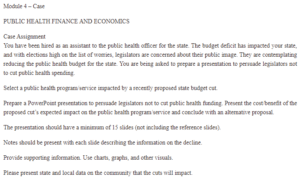
Public Health Finance and Economics
Case Assignment
You have been hired as an assistant to the public health officer for the state. The budget deficit has impacted your state, and with elections high on the list of worries, legislators are concerned about their public image. They are contemplating reducing the public health budget for the state. You are being asked to prepare a presentation to persuade legislators not to cut public health spending.
Select a public health program/service impacted by a recently proposed state budget cut.
Prepare a PowerPoint presentation to persuade legislators not to cut public health funding. Present the cost/benefit of the proposed cut’s expected impact on the public health program/service and conclude with an alternative proposal.
The presentation should have a minimum of 15 slides (not including the reference slides).
Notes should be present with each slide describing the information on the decline.
Provide supporting information. Use charts, graphs, and other visuals.
Please present state and local data on the community that the cuts will impact.


